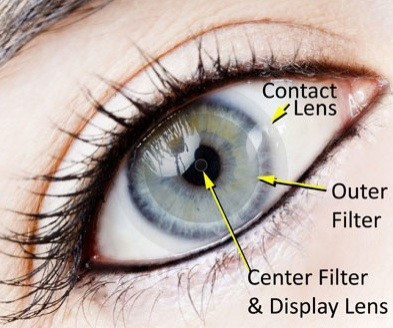Contact Lenses: How They Will Bring Virtual Reality to U.S. Soldiers by 2013

It has been the stuff of science fiction for decades, but the U.S. military announced on Tuesday it is close to developing a virtual reality contact lens to enhance soldiers' vision on the battlefield.
The Defense Advanced Research Projects Agency, or DARPA, is working with Washington-based company Innovega to develop a system of contact lenses and small, wearable glasses giving soldiers battelfield information in realtime.
The Terminator-style vision would enable soldiers to simultaneously focus on the battlefield and mission data, such as live video from an overhead drone, at the same time.
Innovega, which demonstrated the technology at CES in January, hopes to have a consumer version of the iOptik system ready by late 2014.
Innovega CEO Steve Willey said the augmented vision would make the soldier, the ultimate interface.
We aim to have a fieldable prototype available for the DoD by 2013, he noted, adding that, The system would enable the soldier to remotely pilot drones and robots, allowing their eyes to 'be' where the robot is.
Willey explained that the system could also be useful for battlefield medics, who would be able to operate on patients while being jacked into the instruments surrounding them.
The problem for Innovega designers was that a 'natural' human eye cannot focus on objects at very close distances.
Although it is possible to correct this with standard contact lenses, the eye cannot focus on both a close-up, projected image and distance-vision at the same time, forcing the user to switch between the two.
However, the iOptik lens allows the wearer to focus on far-away objects and images projected on the wearable glasses at the same time.
Video feeds, mission data or the location of comrades appear to be overlaid, or augmented, on top of a wearer's normal view of the real world.
The system is a huge improvement over previous virtual-reality headsets, which were extremely bulky and impractical for use on a battlefield.
The iOptik lenses work by using an in-built system of filters and secondary lenses that block out light from the glasses, while at the same time refocusing a narrow beam of light from the glasses back into the pupil.
The project is part of DARPA's Soldier Centric Imaging via Computational Cameras (SCENICC) program, which aims to give warfighters access to systems that greatly enhance their awareness, security and survivability.
The military hopes that the technology will allow soldiers to receive mission critical information such as live video feeds from overhead drones, updated mission data and satellite feeds while still being aware of the battlefield around them.
It could also be used to provide soldiers with magnified vision and other enhancements.
© Copyright IBTimes 2024. All rights reserved.





















